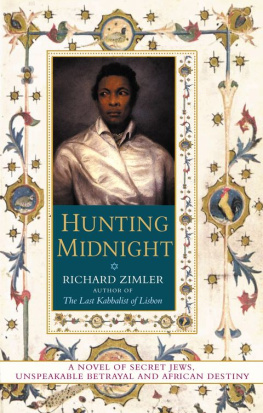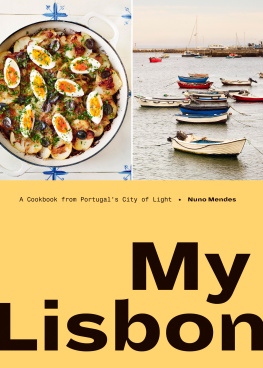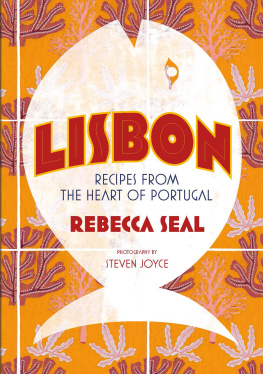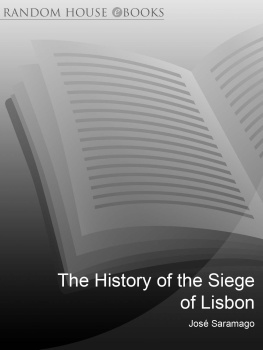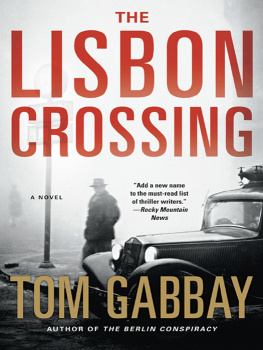Richard Zimler - The Last Kabbalist of Lisbon
Here you can read online Richard Zimler - The Last Kabbalist of Lisbon full text of the book (entire story) in english for free. Download pdf and epub, get meaning, cover and reviews about this ebook. year: 1998, publisher: Arcadia Books, genre: Detective and thriller. Description of the work, (preface) as well as reviews are available. Best literature library LitArk.com created for fans of good reading and offers a wide selection of genres:
Romance novel
Science fiction
Adventure
Detective
Science
History
Home and family
Prose
Art
Politics
Computer
Non-fiction
Religion
Business
Children
Humor
Choose a favorite category and find really read worthwhile books. Enjoy immersion in the world of imagination, feel the emotions of the characters or learn something new for yourself, make an fascinating discovery.
- Book:The Last Kabbalist of Lisbon
- Author:
- Publisher:Arcadia Books
- Genre:
- Year:1998
- Rating:3 / 5
- Favourites:Add to favourites
- Your mark:
- 60
- 1
- 2
- 3
- 4
- 5
The Last Kabbalist of Lisbon: summary, description and annotation
We offer to read an annotation, description, summary or preface (depends on what the author of the book "The Last Kabbalist of Lisbon" wrote himself). If you haven't found the necessary information about the book — write in the comments, we will try to find it.
The Last Kabbalist of Lisbon — read online for free the complete book (whole text) full work
Below is the text of the book, divided by pages. System saving the place of the last page read, allows you to conveniently read the book "The Last Kabbalist of Lisbon" online for free, without having to search again every time where you left off. Put a bookmark, and you can go to the page where you finished reading at any time.
Font size:
Interval:
Bookmark:
An exciting mystery set in sixteenth-century Portugal. Abraham Zarco, a member of Lisbons kabbalist school, is found dead with a naked young woman in a sealed room. His nephew, Berekiah, has to solve the murder Fiona Pitt-Kethley, Books of the Year, DailyTelegraph
Explosive, prophetic and unquestionably brave Newsday
Zimler has a good eye for location and the intrigue is flavoured with an extra layer of kabbalistic mystery: riddles, talismans, ghostly visions and, for dybbuk-lovers, even an exorcism JewishChronicle
A literary and historical treat revel in the mysticism LibraryJournal
In its authentic evocation of Lisbons clandestine Jewish community, its aura of constant menace and its startling, beautiful imagery steeped in Jewish mysticism, this exotic story is memorable and haunting PublishersWeekly
Prophetic and brave an instant best-seller TimesLiterarySupplement
This unforgettable novel will attract widespread attention. The fever pitch of intensity Zimler maintains is at times overwhelming but never less than appropriate to the Hieronymous Bosch-like horrors he describes Booklist
The most readable and memorable novel to have come my way this year Francis King, Books of the Year, GayTimes
Zimler writes with such detail and polarity that the reader feels transported across space and time a delicious slice of sixteenth-century life and a story well told LondonJewishNews
A compelling and atmospheric thriller, couched in prose of elegance and gritty strength CrimeTime
For Alexandre Quintanilha
With thanks to Ruth G. Zimler, Gary Pulsifer, Judith Ravenscroft, Timothy Hyman, Quetzal Editores of Lisbon and Ross Bradshaw of Five Leaves Publications.


In December of 1496, four years after Ferdinand and Isabella of Spain expelled all the Jews from their kingdom, King Manuel of Portugal was convinced to do the same. In exchange, he was to receive from the Spanish monarchs the hand of their daughter in marriage. Just before the expulsion order was to take effect, however, King Manuel decided to convert the Portuguese Jews rather than lose such valuable citizens. In March of 1497, he closed all ports of disembarkation and ordered the Jews rounded up and dragged to the baptism font. Although accounts have reached us of some Jews who committed suicide and murdered their children rather than become Christians, most did indeed agree under coercion to accept Jesus as the Messiah. Called New Christians, they were given twenty years to lose their traditional Jewish customs , a promise which proved hollow over the next two decades of prejudice and imprisonment. Even so, many of the New Christians persisted in their beliefs. In secret and at great risk, they said their Hebrew prayers and practiced their rituals, in particular those related to the observance of the Sabbath and the celebration of Jewish holidays. One such secret Jew was Berekiah Zarco, the narrator of TheLastKabbalistofLisbon.

Abraham Vital, a lawyer in private practice in Istanbul, makes a living petitioning the Turkish government to win benefits for persons who, because of injury or illness, can no longer work. In 1981, he waged a successful legal battle on behalf of a fifty-nine year old carpenter named Ayaz Lugo whose right arm and hand were paralyzed in a car crash.
Lugo died in June of 1988. His wife had already passed away six years earlier . They were childless. In his will, a grateful Lugo left Abraham Vital his home.
I was to stay in Lugos house during the seven-month sojourn I spent in Istanbul in 1990 researching Sephardic poetry, in particular, the ballad form. It was graciously offered to me rent-free by Abraham Vital; he and I became acquainted through a mutual friend, my thesis advisor Dr. Isaac Silva Rosa, formerly of U.C. Berkeley and now of the University of Porto in Portugal.
Both Vital and Lugo are Sephardim, descendents of the waves of Jews who fled persecution in Spain and Portugal in the 15th, 16th, 17th and 18th centuries. Their ancestors had been offered exile in Istanbulthen known by Christians and Jews as Constantinopleas early as 1492. In that year, Turkish Sultan Bejazet II welcomed to his kingdom thousands of Sephardic Jews who were complying with an expulsion order issued by King Ferdinand and Queen Isabella of Spain.
On a stifling day in early May, Vital drove me to Ayaz Lugos ancient home at the fringes of Istanbuls medieval Jewish Quarter, the Balat. Two stories of stone and flaking stucco rose up like an abandoned watchtower between a bakery and record store.
I moved in on May 9, 1990. Inside, everything appeared gray-brown, as if in a sepia photograph, until I started removing the dust.
I could touch the sagging ceilings of both floors of the house without standing on my toes. Cones of light filtered in to my bedroom through oval, platter-size windows. The furniture was of heavy, time-worn wood, pieces evidently purchased when Lugo was a boy; now all antiques.
In my bedroom closet I found thousands of sugar cubes neatly stacked in leather suitcases. Apparently, it had been scarce during World War II. Were the cubes already packed away in case Lugo had to make a quick exit? MaybeJewsshouldalwayshaveatleastonesuitcaseprepared, I thought.
In a worm-eaten dresser, under cotton underwear, I found rancid Turkish chocolate bars. I was pleased; Lugo and I undoubtedly shared a sweet tooth.
My bed was an iron frame with a squashed mattress manufactured in Konya. The script of the tag was in Arabic, making it about seventy years old; in the 1920s, the Latin alphabet replaced the Arabic one throughout Turkey.
The house had no shower. One sink gave a thin stream of cold brown water that smelled of chlorine and rust. Lugo and his wife must have gone to the baths.
I had many companion mice. But miraculously, there were no ants and no bedbugs.
That July, Abraham Vital decided to begin bringing the house up to 20th-century, Western standards. Remodeling began with the cellar so that I wouldnt be too disturbed.
On July 18, workmen came across a secret lair, two-feet deep and four-feet square, which had been covered with wood planks and a cement casing. Inside this hiding place sat a tik, the small cylindrical chest used by Sephardic Jews to house the Torah, the first five books of the Old Testament. Decorated with elaborate silver filigree and enamel peacocks, it was found to contain not a Torah, but a leather-bound set of handwritten manuscripts, nine in all.
The manuscripts were in the square, Hebrew script typical of Iberia, the language largely Jewish-Portuguesean old Portuguese written in Hebrew characters. Portions of the early works, however, were in medieval Hebrew itself. The writing was done with a calamus, the reed pen used in Iberia. The paper was in excellent condition.
All but three of the manuscripts bore polished vellum covers on which a title is illuminated with bird-headed letters. Hoopoes, owls, thrushes, European goldfinches and peacocks predominate. One species of hummingbird (remarkably, a New World family of birds) is also pictured. Lacy, intricate geometrical patterns and arabesques form the backgrounds to titles. Gold leaf is used liberally. A bright carmine and the blue of lapis lazuli are the dominant colors.
Font size:
Interval:
Bookmark:
Similar books «The Last Kabbalist of Lisbon»
Look at similar books to The Last Kabbalist of Lisbon. We have selected literature similar in name and meaning in the hope of providing readers with more options to find new, interesting, not yet read works.
Discussion, reviews of the book The Last Kabbalist of Lisbon and just readers' own opinions. Leave your comments, write what you think about the work, its meaning or the main characters. Specify what exactly you liked and what you didn't like, and why you think so.



